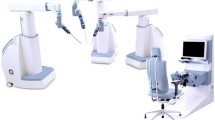Theoretically, in laparoscopic surgery, a computer interface in command of a mechanical system (robot) allows the surgeon: (1) to recover a number a number of lost degrees of freedom, thanks to intra-abdominal articulations; (2) to obtain better visual control of instrument manipulation, thanks to three-dimensional vision; (3) to modulate the amplitude of surgical motions by downscaling and stabilization; (4) to work at a distance from the patient. These advances improve the quality of surgical tasks in a perfect ergonomic position. The purpose of this paper is to evaluate the feasibility of utilizing a robot in laparoscopic surgery. The first robot-assisted procedure in humans was performed in March 1997 by our team. One hundred forty-six patients underwent robot-assisted laparoscopic surgery. Between March 1997 and February 2001 a nonconsecutive series was performed of 39 antireflux procedures, 48 cholecystectomies, 28 tubal reanastomoses, 10 gastroplasties for obesity, 3 inguinal hernias, 3 intrarectal procedures, 2 hysterectomies, 2 cardiac procedures, 2 prostactectomies, 2 arteriovenous fistulas, 1 lumbar sympathectomy, 1 appendectomy, 1 laryngeal exploration, 1 varicocele ligation, 1 endometriosis cure, 1 neosalpingostomy, 1 deferent canal. The robot (Da Vinci system, Intuitive Surgical, Mountain View, CA), consists of a console and a cart with three articulated robot arms. The surgeon sits in front of the console, manipulating joysticklike handles while observing the operative field through binoculars that provide a three-dimensional picture. This computer is capable of modulating these data by eliminating physiologic tremor and by downscaling the amplitude of motions by a factor 5 or 3 to one. This study has demonstrated the feasibility of several laparoscopic robotic procedures. There is no morbidity related to the system. Operating time and the hospital stay were within acceptable limits. The system seems most beneficial in intra-abdominal microsurgery or for manipulations in a very small space. Optimized ergonomics and increased mobility of the instrument tips are beneficial in many steps of abdominal surgical procedures.
Similar content being viewed by others
Author information
Authors and Affiliations
Rights and permissions
About this article
Cite this article
Cadière, M.D., Ph.D., GB., Himpens, M.D., J., Germay, O. et al. Feasibility of Robotic Laparoscopic Surgery: 146 Cases. World J Surg 25, 1467–1477 (2001). https://doi.org/10.1007/s00268-001-0132-2
Issue Date:
DOI: https://doi.org/10.1007/s00268-001-0132-2




